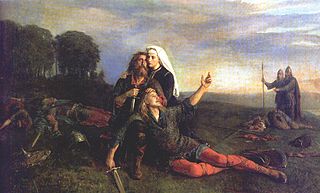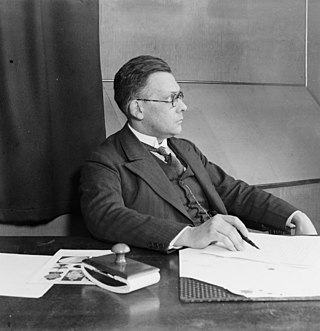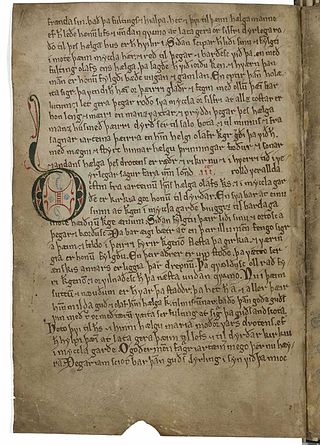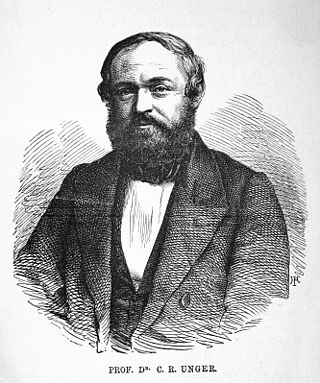Related Research Articles

Old Norse, Old Nordic, or Old Scandinavian, is a stage of development of North Germanic dialects before their final divergence into separate Nordic languages. Old Norse was spoken by inhabitants of Scandinavia and their overseas settlements and chronologically coincides with the Viking Age, the Christianization of Scandinavia and the consolidation of Scandinavian kingdoms from about the 7th to the 15th centuries.
Sagas are prose stories and histories, composed in Iceland and to a lesser extent elsewhere in Scandinavia.

A legendary saga or fornaldarsaga is a Norse saga that, unlike the Icelanders' sagas, takes place before the settlement of Iceland. There are some exceptions, such as Yngvars saga víðförla, which takes place in the 11th century. The sagas were probably all written in Iceland, from about the middle of the 13th century to about 1400, although it is possible that some may be of a later date, such as Hrólfs saga kraka.

Nome is a municipality in Telemark in the county of Vestfold og Telemark in Norway. It is a part of the traditional region of Midt-Telemark and historically of Grenland region. The administrative centre of the municipality is the village of Ulefoss.

The Gray (Grey) Goose Laws are a collection of laws from the Icelandic Commonwealth period. The term Grágás was originally used in a medieval source to refer to a collection of Norwegian laws and was probably mistakenly used to describe the existing collection of Icelandic law during the sixteenth century. The Grágás laws in Iceland were presumably in use until 1262–1264 when Iceland was taken over by the Norwegian crown.

Jan Pieter Marie Laurens de Vries was a Dutch philologist, linguist, religious studies scholar, folklorist, educator, writer, editor and public official who specialized in Germanic studies.
Knut Helle was a Norwegian historian. A professor at the University of Bergen from 1973 to 2000, he specialized in the late medieval history of Norway. He has contributed to several large works.
Lotte Motz, born Lotte Edlis was an Austrian-American scholar, obtaining a Ph.D. in German and philology, who published four books and many scholarly papers, primarily in the fields of Germanic mythology and folklore.
George Tobias Flom was an American professor of linguistics and author of numerous reference books.

The Old Norwegian Homily Book is one of two main collections of Old West Norse sermons. The manuscript was written around 1200, contemporary with the other principal collection of sermons, the Old Icelandic Homily Book; together they represent some of the earliest Old West Norse prose. The two homily books have 11 texts in common, all of which are based on earlier exemplars. Two of these texts, the 'Stave-church Homily' and a St. Michael’s Day sermon, are also found in one of the oldest Icelandic manuscript fragments, AM 237a fol., which was written around 1150.
Gro Steinsland is a Norwegian scholar of medieval studies and history of religion and since August 2009 has been the Scientific Director of the Centre for Advanced Study at the Norwegian Academy of Science and Letters.
Arkiv för nordisk filologi is an annual academic journal of Old Norse and older Scandinavian studies, published by Lund University. It was established in 1882 and was the first scholarly periodical entirely devoted to the field.
Ludvig Holm-Olsen was a Norwegian philologist.

Eugen Mogk was a German academic specialising in Old Norse literature and Germanic mythology. He held a professorship at the University of Leipzig.

Carl Richard Unger was a Norwegian historian and philologist. Unger was professor of Germanic and Romance philology at the University of Christiania from 1862 and was a prolific editor of Old Norse texts.
Menotec was an infrastructure project funded by the Norwegian Research Council (2010–2012) with the aim of transcribing and annotating a text corpus of Old Norwegian texts.

Einar Selvik, also known by his stage name Kvitrafn, is a Norwegian musician known for being the drummer in the black metal band Gorgoroth from 2000 to 2004, and for fronting the Nordic folk project Wardruna, founded in 2002 and also including Gorgoroth's ex-vocalist Gaahl. Selvik and Wardruna's soundtrack work for the History Channel television show Vikings has earned him international prominence, and he also appeared as an actor on the show.
Jan Ragnar Hagland is a Norwegian philologist; a professor of Old Norse at NTNU. He has worked at NTNU since 1972, and became professor in 1986.
Else Olaug Mundal is a Norwegian philologist.
Margrétar saga is an Old Norse-Icelandic saints' saga that tells the story of St Margaret of Antioch. There are three versions of the saga based on at least two translations, and it is extant in more medieval and post-reformation copies than any other saint's legend. Its popularity appears in part to be due to the text's use in childbirth contexts, which was a uniquely Icelandic development of a popular European tradition. The date of the legend's first translation into Old-Norse Icelandic is unknown, but based on the dating of its earliest manuscripts it is taken to have occurred some time before 1300.
References
- ↑ Web page at University of Bergen
- ↑ Stamtre og tekstlandskap (2 vols. 1992)
- ↑ Editing Medieval Manuscripts
- ↑ Medieval Nordic Text Archive
- ↑ Medieval Unicode Font Initiative
- ↑ Menotec project
- ↑ Bibliotheca Nordica website
- ↑ Norröne Grammatik im Überblick (2013)
- ↑ Norrøn grammatikk i hovuddrag (2015)
- ↑ Handbok i norrøn filologi (2013)
- ↑ Handbuch der norrönen Philologie (2020)
- ↑ Le lingue nordiche nel medioevo (2018)
- ↑ Menota catalogue of codices and fragments of codices
- ↑ Menota catalogue of diplomas (charters)
- ↑ Menota catalogue of runic inscriptions
- ↑ The CLARINO project